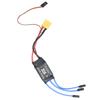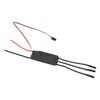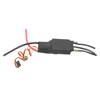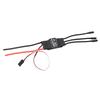Feature:
1. Safe Power On Feature: Our electronic speed controller ensures that the motor won't start immediately upon powering up, regardless of throttle stick position, preventing potential accidents and injuries.
2. Throttle Travel Calibration: Designed to adapt to different remote control throttle ranges, this ESC enhances throttle response linearity, offering a smoothly and delicate speed control experience.
3. Excellent Interference Resistant: The ESC's 30A power input incorporates ultra low impedance and large electrolytic capacitors, significantly enhancing resistant to electrical interference for excellent performance.
4. Comprehensive Safety Functions: With built in under voltage, over voltage, overheat, and remote sign loss safety, our speed controller defends both the system and your equipment effectively.
5. Delicate Craftsmanship: The drone ESC features independent heat sinks for MOSFET output, and microcontroller stability for dependable high current performances.
Specification:
Item Type: Brushless Electronic Speed Controller
Material: PCB
Output Capacity: Continuous current 30A, maximum current 40A (not less than 10 seconds)
Input Power: 5.6V-12.6V (2 to 3S LiPo or 5 to 10S NiMH, NiCd battery pack)
BEC Output: Linear regulator, 2A
Maximum RPM: 2 pole motor 210,000 RPM, 6 pole motor 70,000 RPM, 12 pole motor 35,000 RPM
Suitable for: for FPV F450 Mini Quadcopter Drone
For SIMONK30A (2 to 3S) Technical Parameters:
Drive Current: 30A (MAXIMUM: 40A/10S)
BEC Output: 5V 3A
How to Use:
A. Red positive, black negative, yellow sign wire;
B. Setting Method:
1. Turn on the transmitter and push the throttle to high (for FUTABA series transmitters need to select Reverse for throttle channel).
2. Connect the receiver, motor.
3. Power on the ESC. If the transmitter is working properly, you will hear the following sounds: (If the sound ends with a long beep and no more sounds, check the throttle channel reverse setting on the transmitter).
B B indicates LIPO automatic safety.
BB BB indicates NIMH NICD automatic safety.
BBB BBB indicates brake selection.
(When there is no action, all sounds will continue to loop until there is a request for work).
4. During the sound loop process, when you hear the desired setting, (for example, if selecting LIPO automatic safety, hear a B sound, pull the throttle to the low position quickly). The motor will make an incisive sound to confirm.
5. If there is another setting you want, quickly push the throttle to high to make a selection.
6. Once your desired setting is completed, wait for 2 seconds, the motor will make an appropriate battery safety confirmation sound, and after confirming the throttle position, you can use it.
7. LIPO automatic safety has only 2 safety voltage points, 6V and 9V, the battery does not need to be fully charged.
8. NIMH automatic safety is calculated according to the actual number of batteries, each battery is set to 0.8V, in order to accurately judge the battery voltage, please fill the battery. If it is not full, the electrical regulator will estimate the safety voltage at 70% voltage. (You can also use this feature when using 4LIPO)
C. Brake:
1. The factory settings are none. A brake setting work can be done during actual use, so that the motor uses the back electromotive force to brake after closing the throttle.
2. If you want to remove this brake function, you can set a brake work again, then the function is cancelled.
3. Factory parameter reset function, because this series of electric thermostat has overheating and misoperation safety function, if you find that your electric thermostat acceleration, or steering, or throttle curve and other any characteristics and how to change the new time, then you can do a factory parameter setting, in order to regain high performance.
4. When the device is powered on, it plays a long tone of B, indicating that the LIPO auto safety state is in. BBB plays three tones, indicating that the NIMH NICD auto safety state is in.
Package List:
1 x Brushless Electronic Speed Controller
Note:
Before using, it is recommended to calibrate the throttle range as follows: Connect the ESC, motor, and receiver, push the throttle stick to full, then connect the main power source, hear a 'D' sound and immediately pull the throttle stick to low, then hear 'DD', slowly push the throttle stick to test.








































